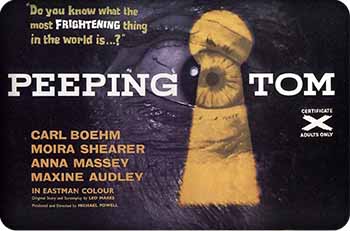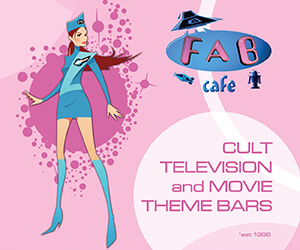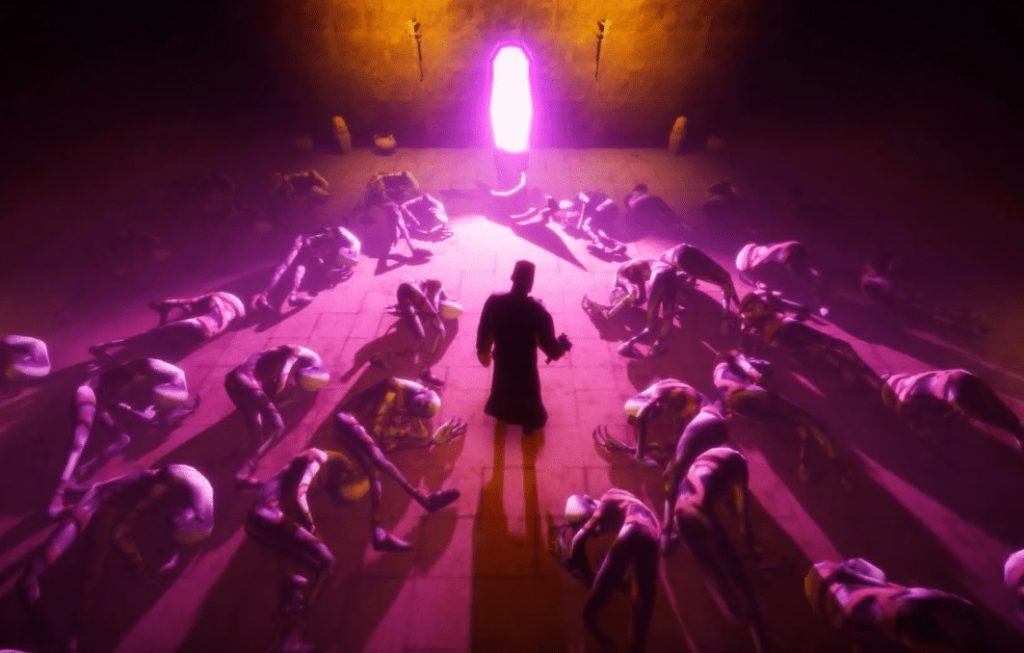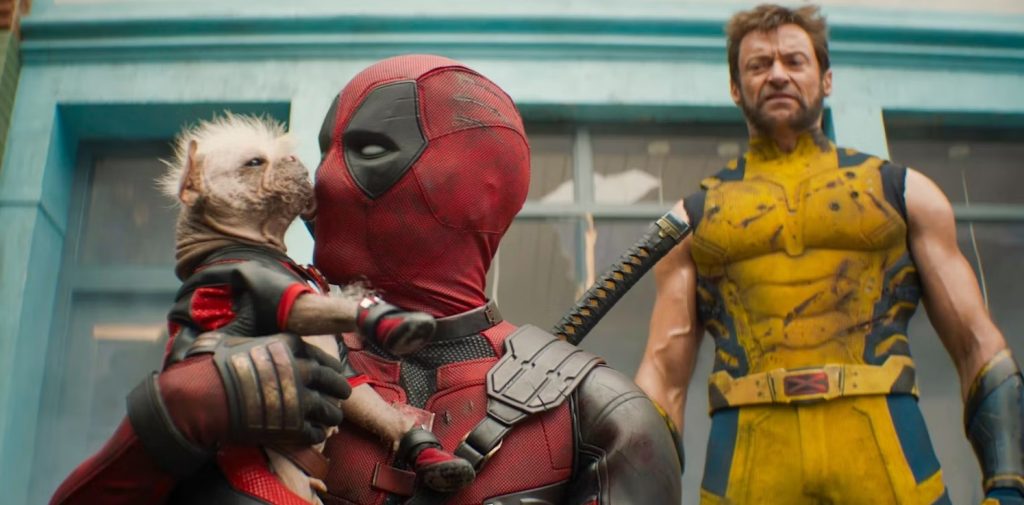 Still as controversial and shocking as it was on its initial release, we glare through the keyhole to find out more about the classic PEEPING TOM…
Still as controversial and shocking as it was on its initial release, we glare through the keyhole to find out more about the classic PEEPING TOM…
It’s an accepted part of the cinematic experience that the audience are voyeurs. Every time we sit in front of the screen, be it at home or in the theatre, we are peering into the lives of others. Surreptitiously gaining access to parts of (albeit fictional) lives of people, watching them interact, go about their business and often get up to no good. It’s strange, then, that when Michael Powell’s Peeping Tom hit the big screen in 1960, audiences and critics alike were uncomfortable with the concept of cinemagoers watching, almost with complicity, a serial killer unflinchingly going about his business.
The film follows Mark (prolific but relatively unknown German actor Karlheinz Böhm, billed here under the Anglo-friendly name Carl Boehm), who is a lowly focus puller at a film studio by day, but makes ends meet by shooting ‘glamour’ photography in his spare time. The pictures are sold under the counter in a Soho tobacconists, although the door and inside walls are emblazoned with near nude photos and magazines. The proprietor is keen for Mark to provide more scintillating content for his clientele, something Mark is somewhat reluctant to do. You see, he has aspirations to be a proper filmmaker, not just pointing the camera at whatever a director wants, or taking nudie snaps for ‘dirty old men’. Perhaps the biggest hurdle he faces in this quest, though, is his compulsion to film women. And not just those who are willing; at night he stalks the streets, picking up prostitutes and brutally murdering them. Every step of the way, his camera is rolling; at the moment of attack, it isn’t sudden, instead, the leg of his tripod is converted to a sharpened spike, the reflector of the camera’s lamp allowing the victim to watch every agonising moment of their death.
It’s this particular part of Mark’s modus operandi that makes his compulsion so sinister, but also makes it easier to trace the cause of the obsession. Mark is a shy, socially awkward fellow; the room at the top of a boarding house is his sanctuary. Little do the other residents know, but he owns the building. It’s only when Helen (Anna Massey) befriends him out of curiosity when she spots him spying on her 21st birthday party that the truth begins to come out.
While showing Helen some of his father’s home movies, which involved the young Mark being filmed being awoken from his sleep by his dad in some rather cruel ways, it’s clear that he is continuing the fixation with filming his victims reaction to fear.

It’s a film that practically finished the career of director Michael Powell. As half of the Powell-Pressburger team, he had made some of the greatest and revered British films of the previous decades. The Life and Death of Colonel Blimp (1943), A Matter of Life and Death (1946), The Red Shoes (1948) and The Tales of Hoffman (1951) are all still held in high esteem. The industry treated him almost like a leper after the release, his reputation only beginning to be restored by the time of his death in 1990. But why would the film cause such problems at the time?
As well as portraying an uncomfortably realistic psychopath, Peeping Tom presents the modern viewer with a time capsule of how things were back in the fifties and sixties, particularly in London’s Soho. Things remained pretty much this way until the more liberal eighties and almost expelled by the Internet age. One of the early standout sequences features the small shop in which Mark sells his photographs. An elderly gentleman (the fabulous character actor Miles Malleson, a veteran of several Hammer and Ealing films) shuffles up to the counter and asks if they have any ‘views’. Pulling a large portfolio from under the counter, the shopkeeper enquires if he means photos ‘like these?’ An excited look appears on the man’s face, which soon turns to awkwardness when a school child enters to buy a chocolate bar. It’s a simple yet very effective and telling scene. One which ends with the man buying the whole book of photos, but declining the offer to put on the shop’s mailing list. So excited, he almost forgets to take with him his ‘cover story’ copy of The Times, which would be used to conceal the paper wrapper (marked ‘educational books’) that hides the illicit photos. When he leaves, the shopkeeper quips, “Well, he won’t be doing the crossword tonight”; he hints to Mark that he wants more explicit content in his work. “What magazines sell the most?” “Those with women on the front covers and no front covers on the women” Mark sheepishly replies in his pseudo-Peter Lorre tone. The film’s frank portrayal of the ‘underground’ adult industry was rather groundbreaking, which was possibly another reason it didn’t sit well with viewers at the time. Everyone knew it took place, lots of people bought it or were involved, but did they need to see it portrayed in such a manner?
The front pages of the newspapers highlight the murder of a prostitute (Brenda Bruce), which we have already seen in the gripping and disconcerting pre-credits sequence. Shot from the camera’s perspective, through a crosswire viewfinder, we see the unwitting lady of the night lead her client to a bedroom. She begins to undress and then becomes terrified as it’s clear an attack is imminent. There’s a sudden cut to a cine projector, and we see Mark sat watching the footage in his room. It’s all the more unsettling for the erratic piano score that accompanies it. By using this POV to establish the connection with Mark, we instantly become ‘peeping toms’, and are almost in collusion with the killer.
As we learn more about the troubled man, however, he becomes a very sympathetic character. Not quite enough to forgive his actions, but certainly understand he is a product of nurture as opposed to nature. Occasionally, we see his awkwardness towards people, women, in particular, but also another side. During a photo shoot with one model (genuine glamour legend Pamela Green), he’s asked “Can you fix it so the bruises don’t show?” A question repeated to him with the introduction of a new model – one who has a facial disfigurement. “He said you needn’t photograph my face”, she slurs. Rather than repulsed, Mark seems in awe, and hastily reaches for his personal cine camera. Filming right up close to her face, he is transfixed, “It’s my first time in front of eyes as full of…” It’s almost as though Mark has identified something in the woman that he can relate to, something that draws him in more than the overt sexuality of Green’s veteran model; something damaged.

Throughout the film, the camera – both Powell’s and Mark’s – replicate that most uncomfortable of things: the male gaze. Using it in such a blatant manner makes it even more troublesome to some viewers. It highlights how a natural instinct – to ‘way up’ a person on first sight – can be damaging and, indeed, violating. What’s different here, and possibly why the use is so disturbing, is that Mark’s intentions are actually not sexual. When confronted with the chance of physical closeness, he becomes an emotional wreck. By caring for Helen, as he does, he has to fight the urge to be with her because he may not be able to resist the risk to harm her. She, after all, tries to understand him and still likes him. The only person who thinks Mark is a threat is Helen’s blind mother (Maxine Audley), who can ‘sense’ the wrongness in him. When confronted by her, he ends up struggling the desire to kill her. The fact the fear she displays is not from her knowing what danger is before her stops him in his tracks; rendering him impotent, so to speak. He promises never to photograph Helen, and her mother pleads with him to get help.
As mentioned, the film was slated by critics when released. What’s surprising is Peeping Tom was released just months before Alfred Hitchcock’s Psycho. Both movies are similar in theme: that of a murderer born from parental influence. Powell himself also appears in his film as Mark’s father in the home movie ‘experiments’ – his own son, Columba, playing the young Mark. Hitchcock was famous for appearing in his pictures, but this was unlikely to have been the reason. Instead, it was more to ‘keep it in the family’ and ensure the boy on screen understood what was happening, so would not come away traumatised. The big difference (other than being in colour, of course) and possibly the reason Peeping Tom didn’t share the same success as Hitchcock’s classic is the sympathy the viewer feels for Mark. It’s hard to imagine this repulsion now since the film is now rightly considered a masterpiece. Martin Scorsese put his name to a re-release in the late ‘70s and in doing so launched a reappraisal of Powell’s ‘dirty secret’.
It’s lost none of its power to shock, make no mistake. Peeping Tom is a terrifying study of a psychopath, mainly because of the way it is so relatable to cinema in general. To the way audiences process what they see; to our power to find empathy with damaged characters. Most of all, though, is because it exposes us all as voyeurs.
PEEPING TOM screens on Horror Channel (SKY 319, Virgin 149, Freeview 70, Freesat 138) on September 1st.








